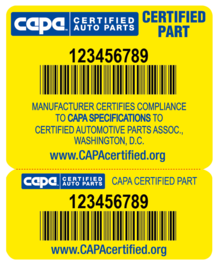How Do I Get CAPA Certified?
If you’re a manufacturer in the U.S., odds are you’ve heard of CAPA certified. As a respected non-profit organization that tests and certifies replacement auto parts, there are numerous benefits to earning their stamp of approval. To help our readers understand the entire certification process, we’ve simplified the steps with four main components.
Process of getting CAPA certified
The steps to certification are relatively easy. Below we’ve outlined everything a manufacturer should prepare for when starting the certification process:
Step 1: Get Manufacturer Facility Approval
Before you can submit an auto part for certification, the facility in which the products are made must be given the green light. What this means is the manufacturer must pass a comprehensive review and inspection of its factory. In addition, the non-profit will thoroughly observe your manufacturing process. Granted no major obstacles stand in your way, the next phase will begin.
Step 2: Obtain Auto Part Certification
Once the facility certification is complete, the manufacturer can then request individual parts for review. CAPA will vigorously test each part for “material properties, fit, finish, paint adhesion, coating performance, weld integrity, adhesive performance and corrosion…”, according to the organization. An auto part that therefore meets quality standards will be awarded with the CAPA Quality Seal.
Step 3: Maintain Auto Part Quality
In order to uphold CAPA certification integrity, the process will not stop there. Any approved manufacturing facility and/or automotive parts will be subject to routine inspections. This ensures quality assurance is maintained throughout the entire course of production of an auto part. If a specific part no longer complies with Quality Standard requirements, the non-profit will then strip the certification, effective immediately.
Step 4: Warranty
It’s important to note that CAPA certification does not permit any type of warranty for your auto parts. All sellers are responsible for the products they sell. Therefore, you must contract your own warranty agreement between you and the buyer. Another key point, CAPA program participants must uphold Quality Standards when selling these certified products. Buyers will know a aftermarket part is certified by checking the manufacturers barcode.

Image source: The Certified Automotive Parts Association
You can learn more about the certification process by visiting capacertified.org. There you’ll find a database of parts that CAPA approved and guidance on your part certification.
Have you considered getting CAPA certified?
Currently there are over 128 million replacement parts certified by the Certified Automotive Parts Association. This type of endorsement offers the best quality assurance of automotive parts in the nation. If you’re still questioning whether automotive parts require CAPA Quality Standards, we hope this information helps make your decision that much easier.
As a reputable headlight manufacturer in a booming industry, we find that CAPA certification sweetens the deal for our buyers. Our customers truly value the accreditation and safety assurance that CAPA offers. Overall, we attribute our success to the quality of our headlamps. Equally important, we are always looking for ways to improve and perfect our manufacturing process. CAPA makes it easy for manufacturers, like us, to keep striving for excellence.















